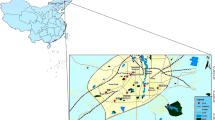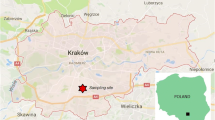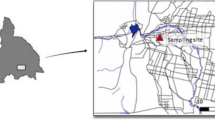Abstract
Introduction
The concentrations of trace metals, ionic species, and carbonaceous components in PM10 (particulate matter with aerodynamic diameters smaller than 10 µm) were measured from samples collected near an industrial complex, primarily composed of cement plants, in southeastern Spain, from September 2005 to August 2006.
Materials and methods
Positive matrix factorization and conditional probability function were applied to this data set to identify different types of sources.
Results
Six significant sources were identified: crustal matter, traffic, aged sea salt, industrial emissions, secondary aerosol, and sea salt. The difficulty of separating anthropogenic sources from those of natural origin is highlighted in this study; in particular, the crustal source can be connected with both natural (African outbreaks, wind resuspension) and man-made emissions, like fugitive emissions in an industrial environment.







Similar content being viewed by others
References
Abbey DE, Nishino N, McDonell WF, Burchette RJ, Knutsen SF, Beeson WL et al (1999) Long-term inhalable particles and other air pollutants related to mortality in nonsmokers. Am J Respir Crit Care Med 159:373–382
Amato F, Pandolfi M, Escrig A, Querol X, Alastuey A, Pey J et al (2009) Quantifying road dust resuspension in urban environment by Multilinear Engine: a comparison with PMF2. Atmos Environ 43:2770–2780
Ashbaugh LL, Malm WC, Sadeh WZ (1985) A residence time probability analysis of sulfur concentrations at Grand Canyon national park. Atmos Environ 19:1263–1270
Begum AB, Kim E, Biswas SK, Hopke PK (2004) Investigation of sources of atmospheric aerosol at urban and semi-urban areas in Bangladesh. Atmos Environ 38:3025–3038
Birch ME, Cary RA (1996) Elemental carbon-based method for monitoring occupational exposures to particulate diesel exhaust. Aerosol Sci Tech 25:221–241
Dockery DW, Pope CA III (1994) Acute respiratory effects of particulate air pollution. Annu Rev Publ Health 15:107–132
Galindo N, Nicolás JF, Yubero E, Caballero S, Pastor C, Crespo J (2008) Factors affecting levels of aerosol sulfate and nitrate on the Western Mediterranean coast. Atmos Res 88:305–313
Hopke PK, Lamb RE, Natusch D (1980) Multielemental characterization of urban roadway dust. Environ Sci Technol 14:164–172
Huerbert BJ, Charlson RJ (2000) Uncertainties in data on organics aerosols. Tellus B 52:1249–1255
Kim BM, Henry RC (2000) Application of SAFER model to the Los Angeles PM10 data. Atmos Environ 34:1747–1759
Kim KH, Hopke PK (2004a) Comparison between conditional probability function and nonparametric regression for fine particle source directions. Atmos Environ 38:4667–4673
Kim E, Hopke PK (2004b) Source apportionment of fine particles at Washington, DC utilizing temperature resolved carbon fractions. J Air Waste Manage 54:773–785
Kim E, Hopke PK, Edgerton ES (2004) Improving source identification of Atlanta aerosol using temperature resolve carbon fractions in positive matrix factorization. Atmos Environ 38:3349–3362
Lippmann M (1998) The 1997 US EPA standards for particulate matter and ozone. In: Hester RE, Harrison RM (eds) Issues in environmental science and technology, 10. Royal Society of Chemistry, London, pp 75–99
Natusch DFS, Wallace JR, Evans CA Jr (1974) Toxic trace elements: preferential concentration in respirable particles. Science 183:202–204
Nicolás J, Chiari M, Crespo J, Garcia Orellana I, Lucarelli F, Nava S et al (2008) Quantification of Saharan and local dust impact in an arid Mediterranean area by the positive matrix factorization (PMF) technique. Atmos Environ 42:8872–8882
Nicolás J, Yubero E, Galindo N, Gimenez J, Castañer R, Carratalá A et al (2009a) Characterization of events by aerosol mass size distributions. J Environ Monit 11:394–399
Nicolás J, Galindo N, Yubero E, Pastor C, Esclapez R, Crespo J (2009b) Aerosol inorganic ions in a Semiarid region on the southeastern Spanish Mediterranean coast. Water Air Soil Poll 201:149–159
Pacyna JM (1986) Emission factors of atmospheric elements. In: Nriagu JO, Davidson CI (eds) Toxic metals in the atmosphere. Wiley, New York, pp 33–52
Paatero P (1997) Least squares formulation of robust non-negative factor analysis. Chemometr Intell Lab 38:223–242
Paatero P (2004) User’s guide for positive matrix factorization programs PMF2 and PMF3, Par. 1: tutorial
Paatero P, Tapper U (1994) Positive matrix factorization: a non-negative factor model with optimal utilization of error estimates of data values. Environmetrics 5:111–126
Paatero P, Hopke PK (2003) Discarding or downweighting high-noise variables in factor analytic models. Anal Chim Acta 490:277–289
Paatero P, Hopke PK, Song X, Ramadan Z (2002) Understanding and controlling rotations in factor analytic models. Chemometr Intell Lab 60:253–264
Pakkanen T, Loukkola K, Korhonen C, Aurela M, Mäkelä T, Hillamo R et al (2001) Sources and chemical composition of atmospheric fine and coarse particles in the Helsinki area. Atmos Environ 35:5381–5391
Polissar AV, Hopke PK, Paatero P, Malm WC, Sisler JF (1998) Atmospheric aerosol over Alaska 2. Elemental composition and sources. J Geophys Res 103(D15):19045–19057
Qin Y, Oduyemi K, Chan LY (2002) Comparative testing of PMF and CFA models. Chemometr Intell Lab 61:75–87
Querol X, Alastuey A, Moreno T, Viana MM, Castillo S, Pey J et al (2008) Spatial and temporal variations in airborne particulate matter (PM10 and PM2.5) across Spain 1999–2005. Atmos Environ 42:3964–3979
Salvador P, Artiñano B, Querol X, Alastuey A, Costoya M (2007) Characterisation of local and external contributions of atmospheric particulate matter at a background coastal site. Atmos Environ 41:1–17
Tauler R, Viana M, Querol X, Alastuey A, Flight RM, Wentzell PD et al (2009) Comparison of the results obtained by four receptor modeling methods in aerosol source apportionment studies. Atmos Environ 43:3989–3997
Thorpe A, Harrison RM (2008) Sources and properties of non-exhaust particulate matter from road traffic: a review. Sci Total Environ 400:270–282
Viana M, Kuhlbusch TAJ, Querol X, Alastuey A, Harrison RM, Hopke PK et al (2008) Source apportionment of particulate matter in Europe: a review of methods and results. J Aerosol Sci 39:827–849
Acknowledgments
We thank the Elche City Hall for allowing access to their facilities for the placement of the instruments, the Air Quality Surveillance Network of the Valencian Community Regional Government for supplying data, and Paul Nordstrom and Guillermo Escribano for their assistance in this work. This work was funded by research project from the Spanish Ministry of Environment (GRACCIE-CSD2007-00067)
Author information
Authors and Affiliations
Corresponding author
Additional information
Responsible editor: Euripides Stephanou.
Rights and permissions
About this article
Cite this article
Yubero, E., Carratalá, A., Crespo, J. et al. PM10 source apportionment in the surroundings of the San Vicente del Raspeig cement plant complex in southeastern Spain. Environ Sci Pollut Res 18, 64–74 (2011). https://doi.org/10.1007/s11356-010-0352-9
Received:
Accepted:
Published:
Issue Date:
DOI: https://doi.org/10.1007/s11356-010-0352-9




